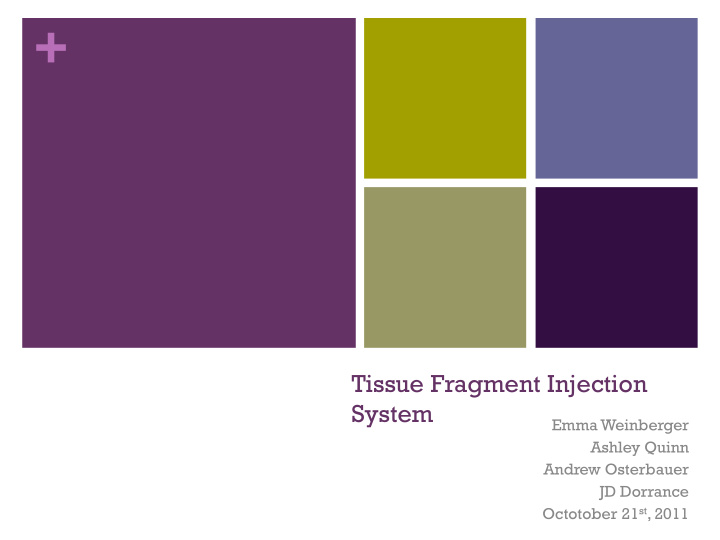



+ Tissue Fragment Injection System Emma Weinberger Ashley Quinn Andrew Osterbauer JD Dorrance Octotober 21 st , 2011
+ Points of Interest Client Information Final Design Problem Statement Future Work Background: Vx-2 Conclusions Current Methods: Surgical & Questions Percutaneous Design Criteria Design Alternatives Design Matrix
+ Client Information Dr. Chris Brace UW-Madison, Department of Radiology and Biomedical Engineering
+ Problem Statement Injection of Vx-2 carcinoma tumor cells in rabbit livers Percutaneous less invasive than surgical Limitations Suturing Unwanted seeding Backflow Eliminate limitations and lower technical skill required
+ Vx-2 Carcinoma Tumor Model Liver is most common site for metastases Used in rabbits to study liver cancer growth and develop treatments Similar characteristics to human liver tumors Luo et al
+ Surgical Method Most common implantation method Advantages Easy access to implantation site Accurate cell placement Minimal unwanted seeding in abdominal cavity Limitations include Long recovery time Anesthetic complications Length of procedure Dr. Brace’s current protocol is surgical
+ Existing Percutaneous Method 16-gauge needle with a 14-gauge sheath Wire used to push out tumor cells Guided by ultra sound imaging Lee K-H et al
+ Design Criteria Seed tumor cells to the liver Prevent unwanted tumor cell seeding Decrease procedure time Decrease technical skill Biocompatible materials 18-gauge needle 5 cm insertion depth Ergonomics
+ Design Alternatives: Cellular Delivery Mechanism (CDM) Mechanical release Uses two coaxial needles 20-gauge and 18-gauge The 20-gauge has a specialized end Cells directly loaded into compartment 20G Needle Mechanical Compartment
+ Design Alternatives: PLGA Capsule 12 mm Polylactic-co- glycolic acid PLGA 1.0 mm Biodegradable 1.0 mm Biocompatible Tissue Fragment Mechanical flexibility 10.1 mm Dye-casting PLGA
+ PLGA Capsule Cont. Biopsy needle Tissue fragment notch Retractable sheath 20mm 18-gague
+ Design Alternatives: PLGA Covering with N-IPAAm Plug 3 Needles 18-gauge guide needle Two 20-gauge needles 1 st : PLGA needle tip & cells 2 nd : N-IPAAm Uses cell suspension 20G Needle PLGA Tip
+ Design Matrix Criteria Weight PLGA PLGA covering and CMD Value Capsule N-IPAAm Plug Cost 10 6 5 7 Ease of use 20 15 12 12 Bio 20 10 8 15 compatibility Ergonomics 10 7 7 7 Reliability 30 18 22 6 Ease of production 10 8 6 4 Total 100 64 60 51
+ Final Design: PLGA Capsule PLGA Tissue Fragment PLGA
+ Future Work Testing with PLGA Testing with biopsy needle Method of PLGA encapsulation “Sandwich” between two sheets Encapsulate in pellet form RARC Certification
+ Conclusions Decreased technical skill required Procedure time reduced Minimal unwanted seeding Minimal backflow of cells
+ Acknowledgements Dr. Chris Brace - Client Dr. Randolph Ashton - Advisor
+ References Brace, Chris. Person interview. September 9, 2011. Georges et al. Two Shope papillomavirus-associated VX-2 carcinoma cell lines with different levels of keratinocyte differentiation and transplantability. Journal of Virology vol. 55:346-350, July 1985. Lee K-H et al. Percutaneous US-guided implantation of vx-2 carcinoma into rabbit liver: A comparison with open surgical method. J Surg Res 155:95-99, 2009. Moore DH, Stone RS, Shope RE, et al. Ultrastructure and site formation of rabbit papilloma virus. Proc Soc Exp Biol Med Jul;1959 101:575. [PubMed: 13675323] Luo et al. Role of sonography for implantationand sequential evaluation of a VX2 rabbit liver tumor model. J Ultrasound Med 2010; 29:51 – 60.
+
Recommend
More recommend